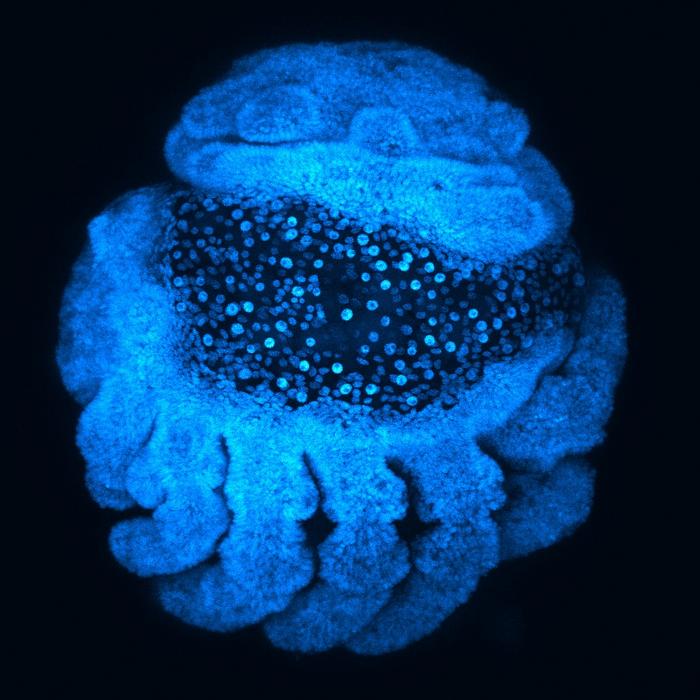An ancient gene is crucial for the development of the distinctive waist that divides the spider body plan in two, according to a study publishing August 29th in the open-access journal PLOS Biology by Emily Setton from the University of Wisconsin-Madison, US, and colleagues.

Credit: E.V.W. Setton et al., 2024, PLOS Biology (CC-BY 4.0, https://creativecommons.org/licenses/by/4.0/)
An ancient gene is crucial for the development of the distinctive waist that divides the spider body plan in two, according to a study publishing August 29th in the open-access journal PLOS Biology by Emily Setton from the University of Wisconsin-Madison, US, and colleagues.
The spider body is divided into two sections, separated by a narrow waist. Compared to insects and crustaceans, relatively little is known about embryonic development in spiders, and the genes involved in the formation of the spider waist are poorly understood.
To investigate, researchers sequenced genes expressed in embryos of the Texas brown tarantula (Aphonopelma hentzi) at different stages of development. They identified 12 genes that are expressed at different levels in embryonic cells on either side of the waist. They silenced each of these candidate genes, one by one, in embryos of the common house spider (Parasteatoda tepidariorum) to understand their function in development. This revealed one gene — which the authors named ‘waist-less’ — that is required for the development of the spider waist. It is part of a family of genes called ‘Iroquois’, which have previously been studied in insects and vertebrates. However, an analysis of the evolutionary history of the Iroquois family suggests that waist-less was lost in the common ancestor of insects and crustaceans. This might explain why waist-less had not been studied previously, because research has tended to focus on insect and crustacean model organisms that lack the gene.
The results demonstrate that an ancient, but previously unstudied gene is critical for the development of the boundary between the front and rear body sections, which is a defining characteristic of chelicerates — the group that includes spiders and mites. Further research is needed to understand the role of waist-less in other chelicerates, such as scorpions and harvestman, the authors say.
The authors add, “Our work identified a new and unexpected gene involved in patterning the iconic spider body plan. More broadly, this work highlights the function of new genes in ancient groups of animals.”
An ancient gene is crucial for the development of the distinctive waist that divides the spider body plan in two, according to a study publishing August 29th in the open-access journal PLOS Biology by Emily Setton from the University of Wisconsin-Madison, US, and colleagues.
The spider body is divided into two sections, separated by a narrow waist. Compared to insects and crustaceans, relatively little is known about embryonic development in spiders, and the genes involved in the formation of the spider waist are poorly understood.
To investigate, researchers sequenced genes expressed in embryos of the Texas brown tarantula (Aphonopelma hentzi) at different stages of development. They identified 12 genes that are expressed at different levels in embryonic cells on either side of the waist. They silenced each of these candidate genes, one by one, in embryos of the common house spider (Parasteatoda tepidariorum) to understand their function in development. This revealed one gene — which the authors named ‘waist-less’ — that is required for the development of the spider waist. It is part of a family of genes called ‘Iroquois’, which have previously been studied in insects and vertebrates. However, an analysis of the evolutionary history of the Iroquois family suggests that waist-less was lost in the common ancestor of insects and crustaceans. This might explain why waist-less had not been studied previously, because research has tended to focus on insect and crustacean model organisms that lack the gene.
The results demonstrate that an ancient, but previously unstudied gene is critical for the development of the boundary between the front and rear body sections, which is a defining characteristic of chelicerates — the group that includes spiders and mites. Further research is needed to understand the role of waist-less in other chelicerates, such as scorpions and harvestman, the authors say.
The authors add, “Our work identified a new and unexpected gene involved in patterning the iconic spider body plan. More broadly, this work highlights the function of new genes in ancient groups of animals.”
#####
In your coverage, please use this URL to provide access to the freely available paper in PLOS Biology: http://journals.plos.org/plosbiology/article?id=10.1371/journal.pbio.3002771
Citation: Setton EVW, Ballesteros JA, Blaszczyk PO, Klementz BC, Sharma PP (2024) A taxon-restricted duplicate of Iroquois3 is required for patterning the spider waist. PLoS Biol 22(8): e3002771. https://doi.org/10.1371/journal.pbio.3002771
Author Countries: United States
Funding: This work was supported by the National Science Foundation (IOS-1552610 and IOS-2016141 to PPS) (nsf.gov). Additional support to EVWS came from The National Science Foundation Graduate Research Fellowship (DGE-1747503 to EVWS) (nsf.gov). The funders had no role in study design, data collection and analysis, decision to publish, or preparation of the manuscript.
Journal
PLoS Biology
DOI
10.1371/journal.pbio.3002771
Method of Research
Experimental study
Subject of Research
Animals
COI Statement
Competing interests: The authors have declared that no competing interests exist.




